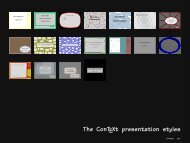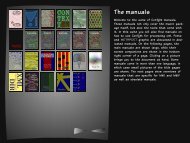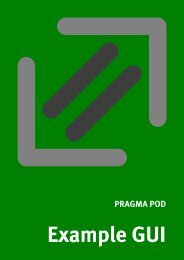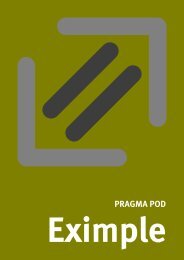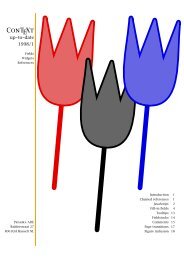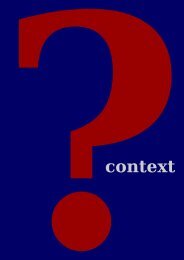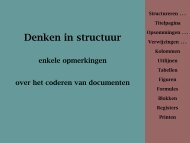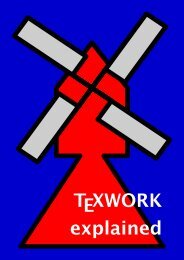You also want an ePaper? Increase the reach of your titles
YUMPU automatically turns print PDFs into web optimized ePapers that Google loves.
CHEMMLConT E Xt XML<strong>Pragma</strong> <strong>ADE</strong> / Hasselt NLGoBack Previous Next Exit
DescriptionThe chemical XML markup dialect provided by CONTEXT is relatively simple, but sufficient foreveryday chemistry. Of course we have elements that represent the building blocks of chemistry:• atoms• ions• moleculesConTEXt XMLIn addition there are methods for:• reactions• bondsReactions, molecules and ions can be annotated. For this we provide:• captionsFor the moment there are no provisions for structure formulas, but there will be some day(probably build on top of the CONTEXT module PPCHTEX).Beware: the spacing may be improved and therefore can change slightly in future versions.<strong>ChemML</strong> 1 GoBack Previous Next Exit
StructureThe simplest building block is the atom: H ConTEXt XMLYou can dress up an atom with a couple of ornaments: Rx H652Rx −5339 6You (or nature) can combine atoms in molecules: H O <strong>ChemML</strong> 2 GoBack Previous Next Exit
H 2OAn efficient way of identifying multiple molecules is the following: H O ConTEXt XML2H 2OAs you can see, a molecule is just a series of atoms and again, we can add a couple of ornaments. H O 2H 2 +1 O −2Atoms with a charge are called ions. Because a charge can be associated to a combination ofatoms, you can also package the atoms in an ion element. H O <strong>ChemML</strong> 3 GoBack Previous Next Exit
2H 2 +2 O −2You can influence the appearance of a ion. Take the following acid: C O O H ConTEXt XMLCOOH −1A different way to visualize the charge is to use brackets around an ion. You can force this witha directive. C O O H <strong>ChemML</strong> 4 GoBack Previous Next Exit
[COOH] −1As you can see in the next example, the negative charge of the whole end up above the numberof Y atoms.ConTEXt XML X Y XY 3−1A molecule seldom comes alone. This is why we have an encapsulating element dealing withreactions. This is a presentational element, which means that we just have a sequence of itemsto be represented. H <strong>ChemML</strong> 5 GoBack Previous Next Exit
O H O wet feet H O ConTEXt XML2H 2+ O 2 ←−−−−−−−−−−→ 2H 2O −−−−−→wet feet2H 2OThe following special symbols are available:<strong>ChemML</strong> 6 GoBack Previous Next Exit
element representationplus +minus−equal =gives−−−−−→equilibrium ←−−−−−−−−−−→mesomeric ←−−−−−→ConTEXt XMLYou can put some text (often expressing conditions) on top or below the arrows. In that case youneed to add a couple or more elements and non empty alternatives of the arrow elements.first entryfirst entrysecond entry<strong>ChemML</strong> 7 GoBack Previous Next Exit
−−−−−→−−−−−→first entrysecond entry−−−−−→first entry−−−−−→ConTEXt XMLYou can also add captions to molecules and ions. If you want a caption to an atom, you need toencapsulate it in a molecule. H hydrogen O oxygen hefty <strong>ChemML</strong> 8 GoBack Previous Next Exit
You can also use a more verbose series of commands to achieve this visualization. H C C H ConTEXt XMLH C C HNormally the typesetting engine will adapt itself automatically to either in--line or displaychemistry. The next example shows in--line usage.When we manage to bring H (hydrogen) in contact with O (oxygen) we get a bit of noise and fire but we end up with H O (water).When we manage to bring H (hydrogen) in contact with O (oxygen) we get a bit of noise andfire but we end up with H 2O (water).<strong>ChemML</strong> 10GoBack Previous Next Exit
However, if you want to have a bit more control, you should use one of the following capsules.The normal element acts chooses one of these, depending on the circumstances.elementichemdchemmeaningin--line Chemistrydisplay ChemistryConTEXt XMLUsageThis module is loaded as any module:\usemodule[chemml]XML exampleHere we will collect a few examples.ConfiguringWe will add some more control over spacing, lettering and color later.<strong>ChemML</strong> 11GoBack Previous Next Exit
DocumentationThere is no additional documentation. The TEX counterpart of this module, namely PPCHTEX,uses a representation more in tune with the way one codes documents in TEX.ConTEXt XMLColofonThis manual is part of the CONTEXT distribution, and is authored and maintained by Hans Hagen.CONTEXT is developed at PRAGMA <strong>ADE</strong>, Hasselt, The Netherlands. This manual is produced onOctober 26, 2001.<strong>ChemML</strong> 12GoBack Previous Next Exit





